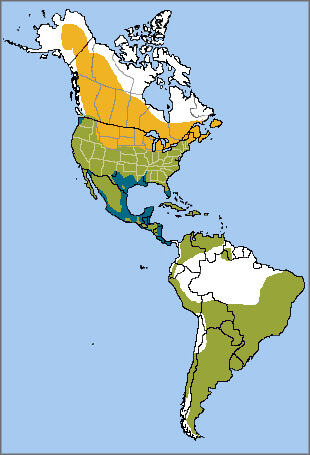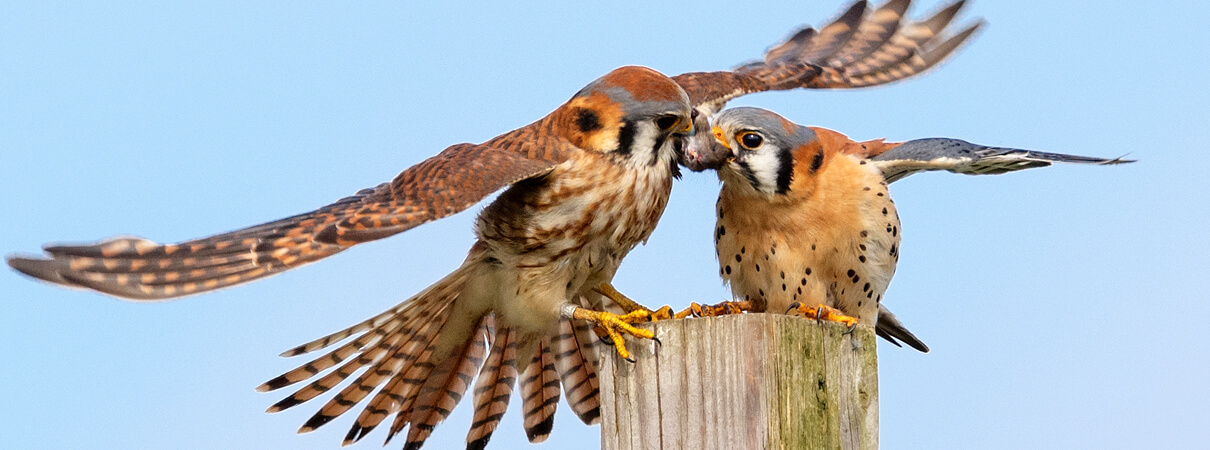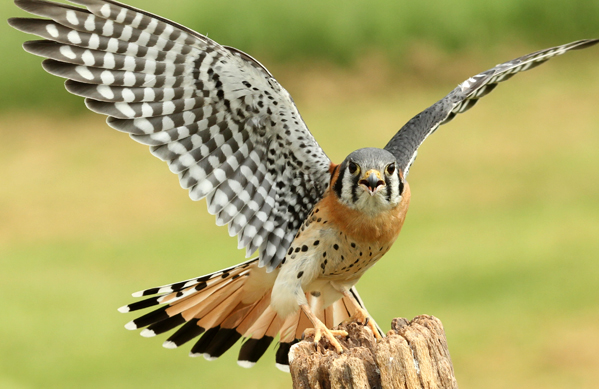 About the size of a Blue Jay, the American Kestrel is the smallest falcon in North America. Common nicknames for this scrappy little raptor include "sparrow hawk" (after the distantly related Eurasian Sparrowhawk), "grasshopper hawk," for one of its favorite prey items, and "killy hawk," due to its shrill call. The American Kestrel is found in the same open habitat as birds including the Eastern Meadowlark and Barn Swallow.
About the size of a Blue Jay, the American Kestrel is the smallest falcon in North America. Common nicknames for this scrappy little raptor include "sparrow hawk" (after the distantly related Eurasian Sparrowhawk), "grasshopper hawk," for one of its favorite prey items, and "killy hawk," due to its shrill call. The American Kestrel is found in the same open habitat as birds including the Eastern Meadowlark and Barn Swallow.
Eyes on the Back of Their Heads
American Kestrels have two black spots, known as ocelli ("little eyes" in Latin), at the back of their heads. These false "eyes" help protect this little falcon from potential attackers sneaking up from the rear, whether they are predators or mobbing songbirds. American Kestrels also have two vertical black facial markings on each side of the head, in contrast to most other falcon species, which only have one.
Wide-Ranging Raptor
Seventeen subspecies of American Kestrel are recognized throughout the species' range, with differences in color, wing length, and plumage patterns. Unlike other raptors such as the Bald Eagle, male and female American Kestrels differ in appearance as well as size. The smaller males are more colorful, with blue-gray wings, orange tail with one black bar, and crisp black spotting on a white belly. Females are rufous and cream with brown barring overall.
Differences between subspecies can be striking. For example, many Caribbean birds lack spots and barring — and the Cuban race is gray-backed and dark-headed, lacking facial stripes.
It's fairly easily to identify an American Kestrel by its fast flight and habit of pumping its tail up and down while perched. This bird is also quite vocal, sounding off with a loud, repeated "killy, killy, killy" when excited or alarmed. Listen here:
(Audio of American Kestrel by Phil Brown XC426298, accessible at www.xeno-canto.org/426298)
The American Kestrel's extensive breeding range stretches from Alaska and northern Canada south into the United States, central Mexico, and the Caribbean, and throughout South America. Most birds breeding in Canada and the northern United States migrate to the southern U.S., Mexico, and Central America for the winter.
Hunting in Ultraviolet
American Kestrels feed on grasshoppers and other insects, as well as lizards, mice, and small birds. This broad diet allows them to successfully inhabit many different areas throughout the Americas.
The kestrel hunts during the day, most often using a “sit-and-wait” strategy similar to an Olive-sided Flycatcher or Flammulated Owl. When a hunting kestrel spots prey, it drops to the ground to capture it, eating on the ground or flying back to a perch with its meal. American Kestrels also hover-hunt when conditions allow: This is when a kestrel, facing into a strong headwind with wings flapping, hangs in one spot in midair, searching the ground below for prey.
Like some other birds including the Rusty-faced Parrot and Ruby-throated Hummingbird, American Kestrels can see ultraviolet light, which is a valuable aid in foraging. In the kestrels' case, the rodents they hunt leave urine trails, which reflect ultraviolet light as they scurry along the ground. These glowing trails, invisible to the human eye, are a sure-fire way for a hungry kestrel to track down a meal.
Colorful Cavity-Nester
This species depends on natural or man-made cavities for successful nesting – it will not nest if a suitable cavity is not available. American Kestrels will use nest boxes of the right size, placed in suitable habitat. Competition for limited sites can become so intense that these falcons may share their space. In one instance, American Kestrels were observed sharing a nest cavity with Eastern Screech-Owls, with each pair raising the young of the other species!
In migratory populations of American Kestrel, males return to the breeding grounds first, then stake out territories. The male finds potential nest cavities within his territory, then shows them to his mate. She makes the final choice. The female kestrel lays three to seven eggs in the unlined cavity, which both parents help to incubate.

American Kestrels, female on left, male on right by Feng Yu, Shutterstock
Kestrel Conservation
Data collected from migration counts, the U.S. Geological Survey's Breeding Bird Survey, and nest-box monitoring programs show steep declines in American Kestrel populations throughout North America, particularly in the Northeast.
A lack of suitable nesting cavities can severely limit American Kestrel numbers, and pesticide use depletes the birds' insect-heavy prey base. Although habitat loss from human development affects these falcons, they have also been impacted by the abandonment of agricultural areas and subsequent reforestation throughout the eastern United States. This increased forest cover has led to an increase in Cooper's Hawks, which prey upon the smaller kestrels. In Latin America, however, a reverse situation occurs: The American Kestrel is one of the few species to benefit from widespread forest clearing.
Interested landowners can find directions for putting up a kestrel box here. The American Kestrel Partnership also provides monitoring opportunities for those interested in kestrel conservation.
ABC has been partnering with other conservation groups, private landowners, and government agencies to manage grassland and forest habitats for the benefit of landowners and native birds. Our Pesticides program continues working to block or restrict dangerous pesticides in agriculture, as well as in homes and gardens.
Donate to support ABC's conservation mission!






















































